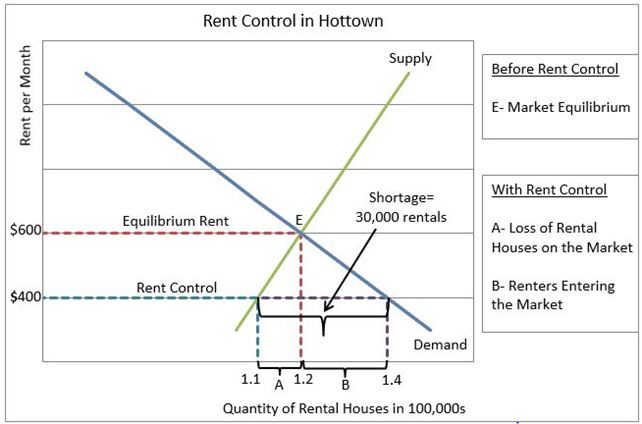Price Ceiling
View FREE Lessons!
Definition of a Price Ceiling:
A
price ceiling establishes the maximum legal price for a good or service. Rent control is an example of a price ceiling because it establishes the maximum rent a tenant can be legally charged.
Detailed Explanation:
Price ceilings have no economic impact when set above the market price, but they can have a dramatic effect when set below the market price. Sometimes, price ceilings protect against rapidly increasing prices during times when the demand for a good has dramatically increased. For example, the US government imposed a price ceiling on several raw materials during World War II when there was concern the prices would increase sufficiently to hamper the war effort. Gasoline prices were controlled in 1973 when shortages pushed the equilibrium price higher. Rent control is another example of a price ceiling.
Affordable housing is becoming more difficult to obtain for many people. Rental rates in many cities have escalated faster than income. High levels of unemployment make housing more difficult to afford, which can lead to undesirable living arrangements for those with limited resources, or worse, it may force some people to live on the streets. Occasionally there is a public outcry about the inequity of these living conditions causing municipalities to place limits on rents, also known as rent control. Today, New York City, which has had some form of rent control for 50 years, sets a maximum for rent on some apartments.
Rents are generally set below the market equilibrium to assist the people who could not otherwise afford the housing costs. The lower rent (price) increases the quantity demanded as it draws residents from apartments that do not have a rent ceiling. As expected, a shortage occurs when the price is below the equilibrium price. Rent control can lead to deteriorating neighborhoods because landlords do not have the incentive to maintain the property when they are required to charge less than the market rental rate. Discrimination and black markets may develop as a way to allocate housing.
The graph below illustrates rent control in Hottown. Rent would equal $600 per month without rent control. The market would provide 120,000 rental houses. Assume the town commissioners establish a ceiling of $400 per month. There is little incentive for landlords to increase the number of rental units. In fact, some may convert housing into office space. The number of units available would drop to 110,000. Meanwhile, many people who did not rent before would be attracted to the lower rent and enter the market. The quantity demanded at $400 equals 140,000 units. There is a shortage of 30,000 units. Unfortunately, this will persist since there is little incentive to increase housing.

Dig Deeper With These Free Lessons:
Supply and Demand – The Costs and Benefits of Price Controls
Who Really Pays an Excise Tax
Managing Supply Using Tariffs, Subsidies, Quotas & Licenses
